Extremely rare - Beautiful Passiflora membranacea!
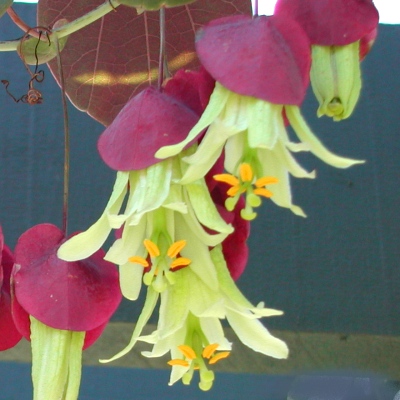
This is a rare offering of the spectacular Passiflora membranacea. Looking like a party decoration, the vine dazzles the eye with greenish-yellow blossoms topped with plum-colored bracts.
Even without blooms it is a striking plant, with its unusual round leaves that are purplish on the back. Since it is a cool-climate species, it is not for everyone. This is a very rare plant that is almost never available online.
Passiflora membranacea is an evergreen vine that grows to 40 feet here in San Francisco. It is very vigorous and can potentially smother nearby trees, so be careful where you grow it.
It looks fabulous when grown over an arbor, where the showy flowers can dangle down like jewelry by their long stems. The 3" blooms appear in summer and fall. The reddish-purple bracts remain after the flowers drop, followed by edible fruit (not self-pollinating however).
The 4" leaves occasionally have small lobes, but they are often perfectly circular, which is extremely unusual for Passifloras.
Passiflora membranacea comes from mountainous parts of Central America and Mexico, where the climate is spring-like all year.
I don't have much information on its climate requirements, but it is probably heat-sensitive and may not flower in temperatures above the upper-80s, particularly if nights are warm.
I don't know its frost tolerance, but it probably can only handle a few degrees of frost. Try to protect it from all frost. It may be grown indoors in a pot, across a trellis. This species likes full sun, although some afternoon shade may be advisable in warmer areas.
Extremely rare Fascicularia bicolor! Stunning Bromeliad
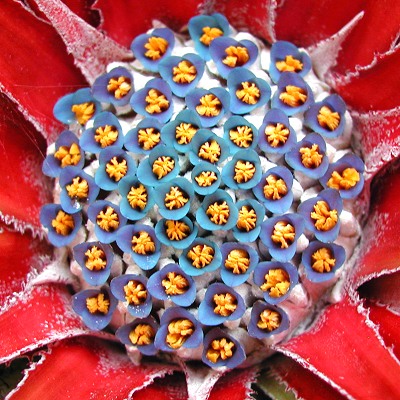
Fascicularia bicolor is a rarely-seen Bromeliad that screams for attention! Just before the plant flowers, the leaves suddenly turn from green to a shocking fluorescent red, as if marked with spray-paint.
I'm not sure what bug pollinates this in the wild, but it must fly in with sunglasses on! The tightly-clustered, sky blue & yellow flowers are simply divine. As exotic as it looks, the plant is frost hardy down to the low 20s. This is a very rare species.
Fascicularia bicolor is a terrestrial Bromeliad from the cool coast of Chile. It forms a rosette of aloe-like leaves around 12-15" long. While the leaves do have spines, they are not very menacing, so it is safe to grow the plant near walkways.
The plant produces many offsets over the years, eventually forming a large colony. You may separate the offsets if you wish, once they have enough roots of their own. Around October, the central leaves of mature plants turn bright red and the flower cluster emerges.
Each bloom in the cluster has 3 blue petals surrounding bright yellow anthers. It's a truly dazzling effect.
Fascicularia comes from a region that has cool, spring-like weather year-round, with cooler nights. I have no information on how it will do in warmer areas like Florida, so consider it experimental in areas that regularly get above 85 degrees, particularly if nights are warm.
It is said to survive down to the low 20s if kept relatively dry. It blooms best in full sun here in San Francisco, although some afternoon shade might be needed in warmer parts of the country. It grows well in a pot in cactus soil, and can be raised indoors as a houseplant.
It seems to flower best when its roots are cramped. But i recommend giving it ample root space the first few years so it can quickly grow to full size. Since it comes from coastal areas, it prefers some humidity in the air — over 50% is recommended.
Seeds are very difficult to germinate, so i'm offering an established plant. This auction is for the plant shown below.
It is a choice, 3 year-old plant about 11 across", with 2 pups emerging. This is the only plant i have available. It will be shipped in its pot of soil, not bare-rooted, to maintain plant health. Promptly sent by 2-3 day Priority Mail. Outside the mainland United States, please email me before bidding for the shipping terms & costs.
Rare "Lavender Pebbles" succulent! - Graptopetalum
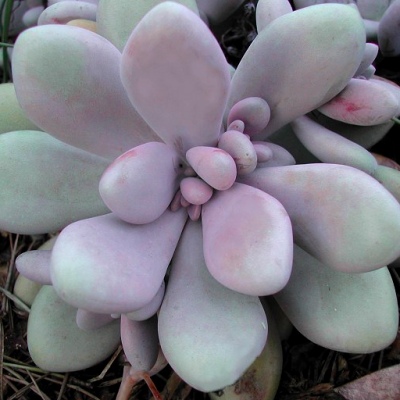
If you like succulents, this is as succulent as it gets! Lavender Pebbles (Graptopetalum amethystinum) is a rare species from Mexico that looks more like moon rocks than a plant! This cool succulent has plump, rounded leaves in lovely shades of lavender, pink, and green.
The leaves have a powdery coating that adds to the eerie, moon rock look. If grown in a hanging planter, they will spill over the edges to 10 or 12 inches. Or let them trail along the ground like a bed of living pebbles!
Lavender Pebbles is related to Jade Plant and Echeveria (Crassulaceae family). The plant grows slowly but steadily, with each stem making about one new leaf per month.
The "chubby" leaves are rounded at the tip, instead of pointy like many related succulents. The lavender or rose shades appear more in the newer leaves, with the older growth turning more greenish.
If you rub off the powdery coating, the colors are more vivid! The pretty, star-shaped flowers appear in large numbers around springtime. The plant normally hangs from steep cliffs in the wild, where it tends to form multiple branches.
You may root the branches if you wish, or even the individual leaves. This is a true species, not a hybrid. It will hybridize with some Echeverias, Sedums, and other succulents.
Lavender Pebbles is native to the Sierra Madre Occidental mountains of west-central Mexico. The climate there is a little cooler than the lowlands, so it enjoys moderate temperatures.
It has handled temperatures in the upper 80s here in California, and will probably grow fine in all but the hottest, driest areas. It's best to protect it from freezing temperatures, although it can probably take a few degrees of frost.
It grows well in either full sun or part sun. Some afternoon shade might be needed in hotter areas. Give it fast draining soil such as cactus mix. The leaves will keep their plump look the best if given adequate water, however keep the plant relatively dry when temperatures get cool.
Rare Cyrtanthus obliquus! - Stunning Amaryllis relative
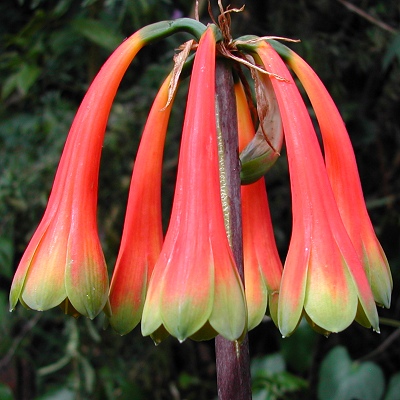
Welcome to the magnificent Cyrtanthus obliquus from South Africa. Rarely seen in cultivation, this relative of Amaryllis and Clivia sends up a dazzling stalk of oversized, nodding blooms in vivid colors.
The foliage is equally impressive. The strap-like leaves spiral as they grow upward, hence the species name obliquus. This plant is untested in warmer areas.
Cyrtanthus obliquus is a summer-growing bulb that tends to go dormant in winter. The large bulb grows to be the size of an orange. The twisting, bluish-green foliage grows about 1½ feet tall straight upwards.
This is the largest species in the genus Cyrtanthus. In the summer, the plant sends up a towering 2 foot-tall scape with around 7-12 blooms, each about 3" long. The general color is a reddish-orange fading to yellow and green toward the flaring ends.
The blooms looks somewhat like Clivia nobilis, and both species happen to be pollinated by similar sunbirds in the wild.
This species comes from a climate with moderate summers, so it might not thrive in very warm areas. Ideal temperatures seem to be about 65-80° F, with nights that are 10 degrees cooler. During the winter dormant period, it should protected from frost and kept relatively dry.
It grows well in a pot in a fast-draining soil mix. A good mix would be 2 parts sand, 2 parts pumice, and 1 part compost. It prefers its roots to be cramped in a narrow but tall pot, with the top half of the bulb exposed.
Give it regular watering during the growing season, but allow the soil to dry somewhat before watering. Full sun is best. In mild temperatures, such as indoors, the plant may stay evergreen.
Fresh seeds of this species are rarely available. This auction is for 6 fresh seeds. Germination tips will be emailed to the winner. Promptly sent in a padded envelope and shipping is $1.50, which includes a tracking number. Outside the USA.
Stunning, rare Haemanthus coccineus! - Paintbrush Lily
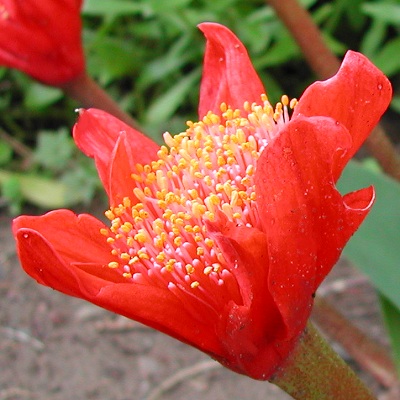
The spectacular Haemanthus coccineus - the Paintbrush Lily - bursts forth with an unusual flower cluster that looks like a big, red shaving brush. This exciting South African bulb is related to Amaryllis and Crinum.
The leaves alone make it worth growing this plant. The oversized, tongue-shaped leaves can reach 20" long and 6" wide, and usually have attractive, red markings underneath. As you can see, the flower stems also have these beautiful markings. This species is rarely available on Ebay.
Haemanthus coccineus usually grows in winter and spring, and goes dormant for the summer. It makes a large, flattened bulb from which 2 fleshy leaves appear (occasionally 3).
For the largest possible leaves, grow the plant in half shade. The bare flower stalk emerges just before the leaves do in late summer, similar to Amaryllis belladonna.
The flower stem grows 6 to 15" tall, and usually has reddish, leopard-spot markings along the lower half. The scarlet-red bracts open to reveal dozens of golden anthers.
Eventually the bulb multiplies into a stunning colony of plants. But even if you only grow a single plant in a pot, it's a real eye-opener!
Haemanthus coccineus is easy to grow if its basic needs are met. It should be kept below about 85 degrees F (29°C) from late summer through mid-spring.
I have read that it can handle 25° F (-4° C), but i would keep it above 35 degrees (2° C). During the summer dormancy, the bulb should be kept dry, and left in the soil. You may grow it in a large pot in a fast-draining soil mix.
Keep the soil regularly watered (but not soggy) during the winter growing period. It grows well both in full sun and in filtered sun/morning sun. In warmer areas, some afternoon shade is a good idea.
Journey to the Poor Knights Islands

Four million years ago, a volcano created some small islands off the coast of New Zealand. Captain Cook discovered the islands in 1760 and named them the Poor Knights Islands. Separated from the mainland for millions of years, the islands developed unique plants and animals found nowhere else on earth. A beautiful example of this is the Poor Knights Lily - Xeronema callistemon.
Xeronema (pronounced Zer-oh-NEM-uh) has unusual bottlebrush flower clusters that grow horizontally, looking like a giant red toothbrush. The flower stalk starts out vertical and then take a curious turn sideways. Stunning red flowers emerge straight up from the stalk, tipped with bright orange pollen.
The total length of the flowering portion averages 7 to 10 inches, although it can potentially get to 18 inches.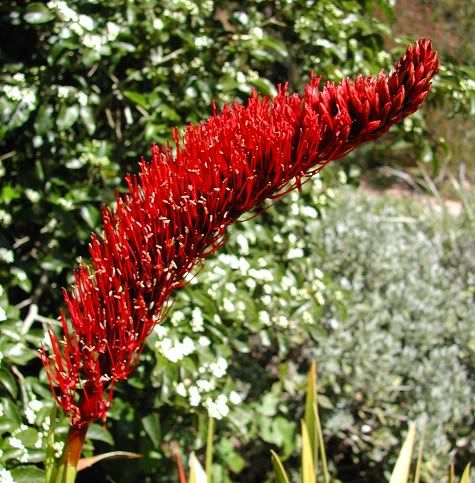
It's illegal to land on the Poor Knights Islands, which are now a protected reserve. This makes Xeronema an extremely rare species that few people grow in the United States.
Xeronema grows about 3 feet tall and forms a colony 6 feet wide, looking somewhat similar to an Iris or Phormium when not in bloom. Even without blooms, it is a gorgeous plant, with perfectly smooth, durable, strap-like leaves that almost feel succulent.
The temperature on the Poor Knights Islands is moderate and stable throughout the year. It rarely gets above 80 degrees or below 40. It has handled temperatures in the upper 80's in cultivation, but this plant should be considered experimental in warmer areas, particularly if nights are warm. It can probably take a few hours of light frost.
In California, it thrives within a few miles of the Pacific. Elsewhere, it's best to grow it a container and move it to a protected spot in winter. It grows well indoors, if the air isn't too dry.
Xeronema prefers mostly-sunny conditions, but give it some afternoon shade in warmer climates. It does best in fast-draining soil, with regular, light waterings. It grows slowly but steadily, putting out new offshoots periodically, which may be separated.
HUGE "Tree Dahlia"! - 20 feet tall - Rare DOUBLE WHITE!
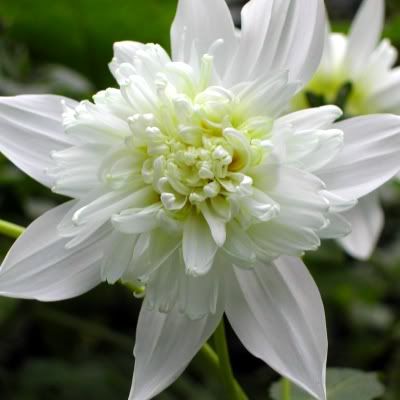
The amazing Tree Dahlia (Dahlia imperialis) has been one of my most popular plants, reaching mind-blowing heights of 20 feet! Even without blooms it's a dramatic plant, with thick, bamboo-like stems, and lush, tropical foliage. People are always amazed when they learn this monster is a Dahlia!
The flowers sprays of the Tree Dahlia are about 2 feet across and contain a dozen or so flowers, which fortunately point downward! The double-white form has lots of crisp white petals, resembling a big, white pom-pom!
The blooms lack the orange center of the original form, because of the fluffy petals and petaloid stamens. Like the original form, the plant can get enormous. You won't believe how fast this plant grows!
The attractive stems grow to 4" thick and are hollow like bamboo. The stems were actually used by the ancient Aztecs as pipes to carry drinking water!
he Tree Dahlia is not really a tree of course, but a tuberous perennial, like other dahlias. This species flowers late in the year, around November/December, so the flowers might get zapped by cold weather in some areas.
In winter, you can cut it back to the ground and new growth will shoot up in the spring. The plant would look great growing next to the pink or purple Tree Dahlia, or all by itself.
Tree Dahlia will flower in Zones 8 to 10, although it's known to flower in Zone 7b in warmer years. The tubers are said to be hardy to 20-25 degrees if planted deep and well-mulched.
In mild-winter areas, it can sometimes flower all the way through April! Protection from strong winds is recommended, as the new shoots and flower sprays are fairly delicate.
Rare Passiflora ambigua! - Tasty tropical species
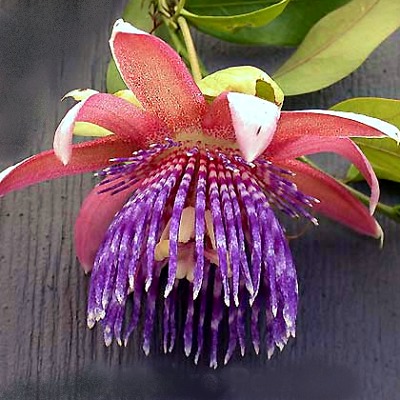
The beautiful Passiflora ambigua has highly decorative blooms 4 to 5 inches across, followed by delicious fruit. This is strictly a tropical vine that needs temperatures over 55 degrees. If you have a large, warm greenhouse, it is an easy and fun Passiflora to grow.
Passiflora ambigua is found in rain forests from southern Mexico to Ecuador, usually at lower elevations, but occasionally as high as 5000 feet. It is a large and fast-growing vine. The flowers have rose colored petals with filaments striped in bluish-purple, white, and red.
The 2" fruits are round and are yellow or orange. They were cultivated by the ancient Mayans and are still sold in markets today. The species name ambigua refers to how the plant is sometimes confused with a similar-looking species, Passiflora laurifolia.
Passiflora ambigua does best with temperatures above 65°. It can tolerate dips into the 50's, although it won't thrive at these temperatures. Like most Passifloras, it enjoys bright light and moist, well-draining soil. It needs some humidity to thrive — over 50% is recommended. Give it the right conditions and it will be one of your fastest growing plants!
This auction is for a 12" vine. It will be shipped in its pot of soil, not bare-rooted, to maintain plant health. Promptly sent by 2-3 day Priority Mail. Shipping to colder areas may be delayed until warmer weather. Outside the contiguous United States.
Rare Impatiens salpinx! Unusual seahorse-shaped blooms!
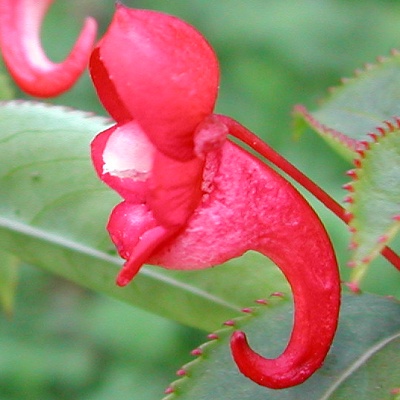
Impatiens salpinx has lots of pinks! And reds too. You won't find this Impatiens in nurseries, since it isn't in cultivation yet. This unusual species has seahorse-shaped flowers and an upright growth habit to 3 feet tall.
The species name "salpinx" is Greek for trumpet, in reference to the horn-shaped blossoms. The plant is found only in a small mountain range on the border of Zimbabwe and Mozambique in southeast Africa.
Due to its limited range, it is considered at risk of becoming extinct. This is an extremely rare plant and practically unavailable.
Impatiens salpinx is a perennial species with attractive, red stems that turn woody at the base.
Its leaves are equally attractive, with serrations that are usually tipped in red. The plant flowers nearly all year long!
The inch-long blooms have shades of frosty pink blending to red, and are suspended by bright red stems. This is a true species, and it readily forms seeds.
Rare Smicrostigma! Weird blue-green staghorn succulent!
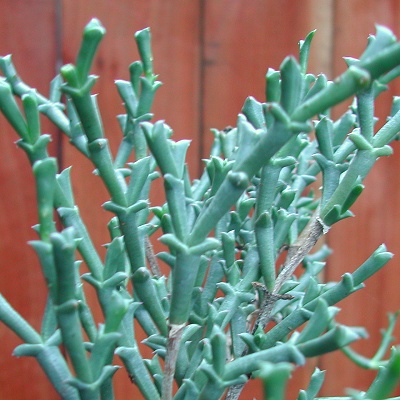
South Africa is the home to almost half the world's 10,000 species of succulents, including the rare Smicrostigma viride.
This unusual Ice Plant relative takes on a odd staghorn shape, with eerie blue-green leaves and stems. Its wedge-shaped leaves are 3-sided and are fused at the base in pairs.
This is a great addition for collectors of strange plants!
Smicrostigma viride is a small, wide shrub that grows 12 to 15" tall. The branches turn woody with age, which is fairly rare for members of the "Mesemb" family (Aizoaceae).
The plant flowers in the spring and summer, with attractive, pinkish blooms. The name "Smicrostigma" refers to the small stigmas of the flower. This is the only species in the genus Smicrostigma.
Smicrostigma is found in semi-desert areas in the Cape provinces of South Africa. Summer temperatures there average in the 80s, but occasionally climb into the 90s and above. It usually dips into the 30s in winter, but rarely drops below freezing.
The plant can probably tolerate a few degrees of frost, but i recommend protecting it from all frost. It is easily grown in a pot, indoors or out. I grow it in a 50/50 mix of potting soil and perlite that's kept lightly moist.
Full sun brings out the blue-green color the most, but some afternoon shade might be needed in the southern part of the U.S.
Global Climate Change Invention Award Goes To 'Kyoto Box

After five months of searching and reviewing thousands of innovative solutions to climate change, the committee of business leaders and climate change experts chosen by the FT Climate Change Challenge, Hewlitt Packard, and the Forum For The Future decided upon a simple, but ingenious solar cooker as winner of its grand prize, $75,000.
Kenyan John Bøhmer, the winning inventor, created his "Kyoto Box" from two cardboard boxes, aluminum foil, black paint, and an acrylic cover - no solar cells or photovoltaic rays.
The device, which cost Bøhner $5 to make, would decrease pollution, deforestation, energy costs, and about 1.3 million deaths a year in Africa alone caused by wood-burning related respiratory illnesses. The life-saving estimate does not even include the number of deaths resulting from contaminated water.
The Kyoto Box is targeted to the three billion people who use firewood to cook. Estimates are that each family that uses wood-burning methods of cooking releases almost 2 tons of carbon dioxide per year into the atmosphere. The Kyoto Box consists of two cardboard boxes, one inside the other, insulated with straw or newspaper between them. The inside of the box is painted in black and the flaps of the boxes are covered in aluminum foil. A transparent layer of acrylic then covers the box. The stove can boil water and bake, but not fry, according to Bøhmer, as the temperature required to fry would burn the box.
"The major thing is that people will be able to boil water," told the BBC News.
Bøhmer will use his $75,000 to further develop the Kyoto Box. One version is being made at a cardboard box factory; another is being developed from a sustainable corrugated plastic.
Tiny Newfound Frog Fits on a Fingertip

A tiny, "midget" frog that can fit on the tip of a finger — and previously only known by its croaking — has finally been found by researchers.
The frog, dubbed Noble’s Pygmy frog (Noblella pygmaea), is the smallest ever found in the Andes and one of the tiniest amphibians in the world.
The amphibian, with an average length of about 0.45 inches (11.4 millimeters) and an unusually long forefinger, was discovered during field work in the highlands of Peru's Manu National Park.
The frog wasn't hard to spot solely because of its small size — its brown color keeps it well camouflaged. But locals helped a team of German and Peruvian herpetologists catch their first glimpse of the creature.
Noblella pygmaea inhabits the cloud forest, the montane scrub and the high-elevation grasslands at an altitude from about 9,900 to 10,500 feet (3025 to 3190 meters) above sea level in and around the park.
The females of the species lay only two eggs that are about 4 millimeters in diameter. Unlike the eggs of most amphibian species, these are laid in moist, terrestrial microhabitats, such as in moss or leaf litter, and are protected from insect predators by the mother frog.
Also unusual is that the embryos don't change into tadpoles, but instead lead a fully terrestrial life immediately after hatching.
Because Manu National Park is a well known biological “hotspot," the scientists that conducted the study, Edgar Lehr of the Senckenberg Natural History Collection Dresden in Germany and Alessandro Catenazzi of the University of California at Berkeley, think that Noblella pygmaea is only one of many undiscovered amphibians in the Andes mountain area. The discovery of Noblella was detailed in the February 2009 issue of the journal Copeia.
Despite living in a nominally protected area, global warming, other human-caused changes to the habitat and the virulent, epidemic fungus Batrachochytrium dendrobatidis, threaten amphibians of the Andean region.
Fortunately, the fungus has not been noticed on Noblella so far. Its terrestrial lifestyle may mean the frog is less exposed to the fungus than stream-dwelling frogs.
The Smallest Fish Ever

Most people don't brag about the smallest fish they ever caught, but when it's the shortest, lightest animal in the world with a backbone, well, that's a catch for scientists.
Researchers in San Diego have identified a new species, the stout infantfish, that's the new champion of petiteness.
Six specimens were caught with very fine plankton nets in the vicinity of Australia's Great Barrier Reef, as well as in the Coral Sea. The largest of these is a mature female only a third of an inch long, which means the stout infantfish unseats the dwarf goby as the world's smallest vertebrate.
If you ordered a pound of these fish at the supermarket, you would end up taking home about a half million of them.
The record holder's nearest relative is twice as long. Like other infantfish, the new species lacks pigmentation, so it is transparent except for its eyes. It also has no teeth or scales - features characteristic of the larval stage in other fish - hence the name "infant". Researchers estimate that these remarkable fish live for only two months.
The discovery highlights the wonders that the ocean continues to reveal.
"This species expands the known size range of vertebrates and demonstrates that we still are far from knowing everything there is to know about the diversity of life," William Watson, from the National Marine Fisheries Service, told LiveScience.
Watson, one of the discoverers, stressed that ecological changes, especially in the Great Barrier Reef, could wipe out species before biologists are able to identify them.
The World's Smallest Refrigerator

Scientists have developed the world's tiniest refrigerator - and it's pretty cold too. Even smaller than a college dorm fridge, the microchip sized fridge can cool objects down to -459 degrees Fahrenheit.
The National Institute of Standards and Technology-designed refrigerators, each 25 by 15 micrometers, are sandwiches of a normal metal, an insulator and a superconducting metal. When a voltage is applied across the sandwich, the hottest electrons "tunnel" from the normal metal through the insulator to the superconductor. The temperature in the normal metal drops dramatically and drains extra heat energy from the objects being cooled.
The researchers used four pairs of these sandwiches to cool the contents of a silicon nitrate membrane that was 450 micrometers on a side and 0.4 micrometers thick. A cube of germanium 250 micrometers on a side, about 11,000 times larger than the combined volume of the fridges was glued on top of the membrane.
This is roughly equivalent to having a refrigerator the size of a person cool an object the size of the Statue of Liberty. Both objects were cooled down to about -459° F.
The refrigerators are made using common chip-making lithography methods, which makes it easy to integrate them in production of other micro scale devices.
These tiny fridges are much smaller and less expensive than conventional equipment. The fridges have applications such as cooling cryogenic sensors in highly sensitive instruments for semiconductor analysis and astronomical research.
The World's Smallest Robot

Researchers have built an inchworm-like robot so small you need a microscope just to see it.
In fact about 200 hundred of them could line up and do the conga across a plain M&M.
The tiny bot measures about 60 micrometers wide (about the width of a human hair) by 250 micrometers long, making it the smallest untethered, controllable microrobot ever.
"It's tens of times smaller in length, and thousands of times smaller in mass than previous untethered microrobots that are controllable," said designer Bruce Donald of Dartmouth University.
"When we say ‘controllable,' it means it's like a car; you can steer it anywhere on a flat surface, and drive it wherever you want to go. It doesn't drive on wheels, but crawls like a silicon inchworm, making tens of thousands of 10-nanometer steps every second.
It turns by putting a silicon 'foot' out and pivoting like a motorcyclist skidding around a tight turn."
Because it makes use of this innovative bending movement and is untethered, it can move freely across a surface without the wires or rails that restricted the mobility of previously developed microrobots. The caterpillar strategy also helped the researchers avoid a common problem in microrobotics.
"Machines this small tend to stick to everything they touch, the way sand sticks to your feet after a day at the beach," said Craig McGray of the National Institute of Standards and Technology.
"So we built these microrobots without any wheels or hinged joints, which must slide smoothly on their bearings. Instead, these robots move by bending their bodies like caterpillars. At very small scales, this machine is surprisingly fast."
To get around, the robot makes use of two independent microactuators – the robot's "muscles." One is for forward motion and the other for turning.
It doesn't have pre-programmed directions. Instead, it reacts to electric changes in the grid of electrodes it moves on. This grid also supplies the microrobot with the power needed to make these movements.
This microrobot and similar versions that could be developed might eventually ensure information security, inspect and make repairs to integrated circuits, explore hazardous environments, or even manipulate human cells or tissues.
Eating Baby Broccoli May Prevent Stomach Cancer

Looks like Mom was right to push those veggies on you as a kid. A new study shows that eating broccoli may protect against stomach cancer.
It seems like there have been a lot of studies done on broccoli lately, and now, scientists have found that eating two and a half ounces of baby broccoli daily for two months could help prevent a stomach bug that is linked to gastritis, ulcers and stomach cancer.
“We identified a food that, if eaten regularly, might potentially have an effect on the cause of a lot of gastric problems and perhaps even ultimately help prevent stomach cancer,†wrote Jed Fahey, nutritional biochemist in the Lewis B. and Dorothy Cullman Cancer Chemoprotection Center at the Johns Hopkins University School of Medicine.
“Broccoli sprouts have a much higher concentration of sulforaphane than mature heads (broccoli).â€
In a study done in Japan, 25 people infected with Helicobacter pylori, a bacterium that causes gastritis, were given 70 grams of broccoli sprouts per day for two months. Twenty-five other infected people were given 70 grams of alfalfa sprouts per day, however, alfalfa sprouts don't contain sulforaphane.
Researchers found levels of a marker of H. pylori called HpSA was cut by over 40 per cent in those who ate broccoli. There was no change at all for the group who ate the alfalfa sprouts.
“We know that a dose of a couple ounces a day of broccoli sprouts is enough to elevate the body's protective enzymes,†Fahey said. “That is the mechanism by which we think a lot of the chemoprotective effects are occurring. But the fact that the levels of infection and inflammation were reduced suggests the likelihood of getting gastritis and ulcers and cancer is probably reduced.â€
Who Invented The TV Remote Control?

In the late 1940's, Eugene McDonald jr., founder and president of Zenith Radio corporation, thought that television ( brand new technology in those days) would be much improved if viewers did not have to watch so many commercials. Apparently commercials were the bane of television viewing from the very beginning.
Mr. McDonald charged his team of engineers with developing a way to mute annoying ads. In a show of lateral thinking, they did him proud. In 1950 the Lazy Bones remote control was introduced to the public. Rather than simply muting the commercials, the new device could actually change the channel from the comfort of your sofa.
The Lazy Bones consisted of a handheld control attached to a cable. The cable was, in turn, connected to an electric motor on the tv. The motor could turn the tuner clockwise or counterclockwise, depending on which button you pushed. There was also a power button for turning the set on and off.
The revolutionary device was wildly popular at first. But consumers soon started to complain about the trip hazard posed by the cable. Mr. McDonald wasn't completely satisfied, either. Lazy Bones was indeed innovative, but it still did not mute commercials. Sure you could change the channel, but you would find the commercials on the next channel as well.
CCD sensor

The CCD sensor, or the charge-coupled device sensor, was created in the 1960s by Bell Laboratories. It was supposed to be a new type of computer memory chip, but since the device proved to be so much more than that, Bell began developing other uses that included signal processing. Since the sensor utilized silicon, it was more sensitive to light, and thus made a good imaging sensor.
Thin layers of silicon process within the unit itself. Each layer has identical layers within it that serve a separate function. Dies are cut from the layers and preserved by an outer, more durable layer to be included in other devices, such as a digital camera.
You cannot just take apart your camera and find the CCD sensor, although in some cameras you can. High-end cameras can be taken apart for you to clean your sensor, but only camera professionals should attempt to do so. If you damage your sensor, you could potentially have to replace your entire digital camera, and that can become costly.
The sensor itself serves to capture an image. It is like an eye, it collects light, converts it to an electric charge and then emits the results that become a static image. Kodak developed one of the most used CCD sensors, it includes thousands of pixels situated in a linera fashion or in a matrix to capture light's intensity in an image. The process is similar to how the eye captures an image for you to constantly see the world around you.
There are several different ways CCD sensors are used. Area arrays allow picture takers to capture motion in one exposure no matter what the shutter speed. Linear arrays focus on one row of pixels to scan an image. From there, it makes three different exposures, one for each color filter, based on reds, blues and greens.
This captures one-dimensional images and captures still subjects. These types of images must have a self-contained light source and can be captured in high-resolution for spectacular detail in the imagery.
Robotic Fly

A realistic robotic fly has spread its wings at the University of Harvard. Despite weighing only 60 milligrams with a wingspan of 3 centimeters, the robotic fly mimics the actions of a real fly contributing to the realism of the mechanical insect. Small robots such as this will be used in the future for spying missions or to enter and explore areas which may contain an element of significant danger.
Robert Wood is leader of the robotic department at Harvard and he believes that flies possess the inconspicuous nature required for such missions, much like a fly-on-the-wall. The robot has been given funding and support by leading military organizations in a conscious effort to develop the fly with respect to implementing it within such circumstances.
The fly was difficult to manufacture due to the intricacy of the individual parts. Existing parts did not exist in a compact enough size so the team had to develop them by themselves.
The process used was laser micro machining, which comprises of cutting extremely thin sheets of carbon fiber and polymer which remain accurate to the nearest micrometer. Arranging both the carbon fiber and polymer practical parts could be developed.
Each part of the robotic fly can bend and rotate to an extent whilst remaining durable. For parts which react to electricity, electro active polymer is used which alters shape when exposed to a current.
Moscow Will House Europe's Biggest Oceanarium

By 2011, It is expected that the proposed enormous oceanarium in Moscow will form part of an amusement complex complete with a cinema, hotel, business center, shopping mall and many restaurants. According to news sources, the Eurasian country of Kazakhstan, which is the world’s largest landlocked country, is financing the construction of one of the new oceanarium.
The oceanarium’s location is well-served by a newly-built Metro station, buses and Moscow's road network and offers access to 16 million potential customers.
According to some news reports, the mayor of Moscow, Yuri Luzhkov, has stated that he hopes the new oceanarium, which will be named “Duman,†will be a perfect center for learning about undersea life and entertainment.
It will also become the very first oceanarium in the Commonwealth of Independent States (CIS), which are those countries composed of former Soviet republics.
City Buses to Run on Human Waste

Stockholm, Sweden, is about to introduce municipal buses powered by the city's waste system.
The biofuel that will power the ciy's buses, even though it will be extracted from municipal wastewater, is considered clean energy, because it's carbon neutral, endlessly renewable, and puts out virtually no pollution—78% less nitrogen oxide and 98% fewer fine particles than the alternative.
The fuel is methane, generated by fermenting sludge from the Stockholm sewage treatment plant, which manages the waste of its 250,000 citizens.
Each of whom will contribute the equivalent of more than two liters of diesel fuel a year.
Pink dolphin appears in US lake

The world's only pink Bottlenose dolphin which was discovered in an inland lake in Louisiana, USA, has become such an attraction that conservationists have warned tourists to leave it alone.
The dolphin appears to be healthy and normal other than its coloration, which is quite beautiful and stunningly pink.
The mammal is entirely pink from tip to tail and has reddish eyes indicating its albinism. The skin appears smooth, glossy pink and without flaws.
Surprisingly, it does not appear to be drastically affected by the environment or sunlight as might be expected considering its condition, although it tends to remain below the surface a little more than the others in the pod.
It is a truly beautiful dolphin but people should be careful, as with any dolphins, to respect it - observe from a distance, limit their time watching, don't chase or harass it.
While this animal looks pink, it is an albino which you can notice in the pink eyes.A close relation of dolphins, the Amazon River Botos, called pink dolphins, live in South America in the Amazon.
Latest Cell Phone-Cancer News:

The debate about the cancer-causing effects of cell phones has been rumbling on for years and years, with contradicting studies coming out every so often.
The real answer to the question of whether phones give people cancer, at this point, seems to be "nobody really knows yet", so any news one way or the other should be taken with a grain of salt (or two).
In any case, the latest study to emerge says mobile phones don't cause eye cancer. Of course, this research contradicts the conclusion of an earlier, smaller study conducted by the same German researchers.
So even though they're calling phones safe -- for your eyes, anyway -- the contradiction seems par for the course.
Mentos with Coca cola

A little boy died in Brazil after eating MENTOS and drinking Coca-Cola / PEPSI together. One year before the same accident happened with another boy in Brazil .
So be careful with your self eating MENTOS (POLO's) and drinking COCA-COLA or PEPSI together.
PASS THIS INFORMATION TO AS MANY PEOPLE AS POSSIBLE ESPECIALLY TO THE CHILDREN, BECAUSE IN OUR COUNTRY MENTOS AND COCA-COLA BOTH ARE VERY POPULAR AMONGST THE CHILDREN.
Vashist Hot Water Springs and Temple:

Manali has many attractions but the chief centre of interest, historically and archeologically, is undoubtedly the DHOONGRI TEMPLE dedicated to goddess Hadimba or Hadimba Devi.
It has four-tiered Pagoda shaped roof and the doorway is carved with legendary figures and symbols. Hadimba Devi Temple in Manali is located amidst wooden forest of deodar is about 2.5 kms. From the Manali Tourist Office. It is a pleasant experience to stroll in the Hadimba Devi Temple complex which was built in 1533 A.D.
Vashist Hot Water Springs and Temple. It is amazing that in a location surrounded by snow and chilling weather, Mother Nature has provided unabated flow of hot water for free to the mankind.
Vashist is located at a distance of about 6 km away from the beautiful town of Manali in the Kullu district of the Indian state of Himachal Pradesh. This place promises to provide the visitors a wonderful view of the beautiful Beas River. The Vashist Hot Water Spring is one of the famous attractions of this region.
The hot water springs that are amply found in this region have made this small village famous to people from all over the world. The hot water springs that come out of the granitic deposits cover a huge part of the Himalayas in this area. The temperature in these hot water springs vary between 110 degree Fahrenheit and 123 degree Fahrenheit.
The Vashist village lies at the foot of a laterite accumulated rocky hill on the left bank of the river Beas. The hill is covered with a large number of pine and deodar trees. The ponds or the water kunds, as they are popularly called, can be found just at the center of the village. The region around these hot water springs of Vashist provides a majestic vies of the enchanting greenery all around.
Creepy Mothers' Day Plants Culled

Thousands of Mothers' Day flowers have been destroyed after florists discovered they were infested by spiders.
A trademark creepy crawler the bunches of roses and carnations were about to be prepared for Sunday's big day when shocked shop assistants realized they were crawling with spiders and infested with eggs.
A waste disposal firm was called in to take the blighted blooms away. "When the van driver arrived at our waste depot to with the flowers, he looked terrified," said Biff a waste firm manager David Graham. He said: "I've never seen a driver so keen to unload.
We employ some big burly fells but none of them were keen to go near this consignment.†The blooms were absolutely crawling with the creepy things."
Experts say the spiders were common British house spiders and were completely harmless but still not the sort of surprise mums would have expected on Mothers' Day. The florists, based in Birmingham, wanted to remain anonymous but have reassured mums that all the affected flowers had now been destroyed.â€
It would have been a nightmare if mums had received the flowers on Mothers' Day, but thankfully that's now been averted," said a spokesman.
The Naming of the Months
JANUARY in Roman mythology, JANUS, the god of doors and gateways and beginnings (which the Romans believed brought good endings). A pretty good name to start the year!
FEBRUARY From FEBRUA, the Feast of Purification, celebrated in ancient Rome. It was not originally included in the Roman calendar which began with March.
MARCH From MARS . In Roman mythology, the god of war, one of the most important gods. Mars was regarded as the father of the Roman people.
APRIL From APRILIS, perhaps from the Greek Aphrodite or a pagan underworld goddess.
MAY Named after Maia, the Roman goddess of the spring.
JUNE In Roman mythology, Juno, queen of the gods and wife and sister of the god Jupiter. She was the protector of women and was worshipped under several names. One of them was Hera.
JULY From JULIUS CAESAR, born in Rome on July 12 or 13 in 100 BC. He was the Roman general and statesman who laid the foundations of the Roman imperial system. In 44 BC he changed the name of the month Quintillis to Julius, after himself. The following year he decided (based on the advice of an astronomer) to use a purely solar calendar with 365 days. This calendar is known as the Julian calendar in his name.
AUGUST From AUGUSTUS CAESAR, born in 63 BC and died in 14 AD. He was the emperor of Rome from 27 BC until his death. He restored unity and orderly government to the empire after nearly a 100 years of civil wars. The month Sextillis was renamed Augustus after him in 45 BC.
SEPTEMBER From the Latin word SEPTEM meaning 7.
OCTOBER From the Latin word OCTO meaning 8.
NOVEMBER From the Latin word NOVEM meaning 9.
DECEMBER From the the Latin word DECEM meaning 10.
Your charcacter by Signing Style
SINGLE UNDERLINE BELOW THE SIGN !!
These persons are very confident and are good personalities. They believe in "Happiness of human life".
TWO DOTS BELOW THE SIGN !!
These persons are considered to be Romantic, can easily change their fiancees as if they change their clothes. They prefer beauty in other persons & they thenselves try to look beautiful. They easily attract others.
SINGLE DOT BELOW THE SIGN !!
These persons are more inclined towards classical arts, simple & are very cool. If you loose faith with them, then these persons will never look back at you. Hence its always better to be careful with these people.
NO UNDERLINES OR DOTS BELOW THE SIGN !!
These persons enjoy their life in their own way, never pay attention to others views. These are considered to be good natured but are selfish too.
RANDOM SIGN, NO SIMILARITY BETWEEN NAME & SIGN !!
These persons try to be very smart, hide each & every matter, never say anything in straight forward manner, never pay attention to the other person of what he is talking of.
RANDOM SIGN, SIMILARITY BETWEEN NAME & SIGN !!
These persons are considered to be intelligent but never think. These people change their ideas & views as fast as the wind changes its direction of flow. They never think whether that particular thing is right or wrong. You can win them just by flattering them.
SIGN IN PRINTED LETTERS !!
These persons are very kind to us, have a good heart, selfless, are ready to sacrifice their life for the sake of their near & dear. But these seems to think a lot and may get angry very soon.
WRITING COMPLETE NAME AS THEIR SIGN !!
These persons are very kind hearted, can adjust themselves to any environment & to the person they are talking. These persons are very firm on their views & posses a lot of will power.
The Naming of the Days
The Greeks named the days week after the sun, the moon and the five known planets, which were in turn named after the gods Ares, Hermes, Zeus, Aphrodite, and Cronus. The Greeks called the days of the week the Theon hemerai "days of the Gods". The Romans substituted their equivalent gods for the Greek gods, Mars, Mercury, Jove (Jupiter), Venus, and Saturn. (The two pantheons are very similar.) The Germanic peoples generally substituted roughly similar gods for the Roman gods, Tiu (Twia), Woden, Thor, Freya (Fria), but did not substitute Saturn.
Sunday -- Sun's day
Middle English sone(n)day or sun(nen)day
Old English sunnandæg "day of the sun"
Germanic sunnon-dagaz "day of the sun"
Latin dies solis "day of the sun"
Ancient Greek hemera heli(o)u, "day of the sun"
Monday -- Moon's day
Middle English monday or mone(n)day
Old English mon(an)dæg "day of the moon"
Latin dies lunae "day of the moon"
Ancient Greek hemera selenes "day of the moon"
Tuesday -- Tiu's day
Middle English tiwesday or tewesday
Old English tiwesdæg "Tiw's (Tiu's) day"
Latin dies Martis "day of Mars"
Ancient Greek hemera Areos "day of Ares"
Tiu (Twia) is the English/Germanic god of war and the sky.
He is identified with the Norse god Tyr.
Mars is the Roman god of war.
Ares is the Greek god of war.
Wednesday -- Woden's day
Middle English wodnesday, wednesday, or wednesdai
Old English wodnesdæg "Woden's day"
Latin dies Mercurii "day of Mercury"
Ancient Greek hemera Hermu "day of Hermes"
Woden is the chief Anglo-Saxon/Teutonic god. Woden is the leader of the Wild Hunt. Woden is from wod "violently insane" + -en "headship". He is identified with the Norse Odin.
Mercury is the Roman god of commerce, travel, theivery, eloquence and science. He is the messenger of the other gods.
Hermes is the Greek god of commerce, invention, cunning, and theft. He is the messenger and herald of the other gods. He serves as patron of travelers and rogues, and as the conductor of the dead to Hades.
Thursday -- Thor's day
Middle English thur(e)sday
Old English thursdæg
Old Norse thorsdagr "Thor's day"
Old English thunresdæg "thunder's day"
Latin dies Jovis "day of Jupiter"
Ancient Greek hemera Dios "day of Zeus".
Thor is the Norse god of thunder. He is represented as riding a chariot drawn by goats and wielding the hammer Miölnir. He is the defender of the Aesir, destined to kill and be killed by the Midgard Serpent.
Jupiter (Jove) is the supreme Roman god and patron of the Roman state. He is noted for creating thunder and lightning.
Zeus is Greek god of the heavens and the supreme Greek god.
Friday -- Freya's day
Middle English fridai
Old English frigedæg "Freya's day"
composed of Frige (genetive singular of Freo) + dæg "day" (most likely) or composed of Frig "Frigg" + dæg "day" (least likely)
Germanic frije-dagaz "Freya's (or Frigg's) day"
Latin dies Veneris "Venus's day"
Ancient Greek hemera Aphrodites "day of Aphrodite"
Freo is identical with freo, meaning free. It is from the Germanic frijaz meaning "beloved, belonging to the loved ones, not in bondage, free".
Freya (Fria) is the Teutonic goddess of love, beauty, and fecundity (prolific procreation). She is identified with the Norse god Freya. She is leader of the Valkyries and one of the Vanir. She is confused in Germany with Frigg.
Frigg (Frigga) is the Teutonic goddess of clouds, the sky, and conjugal (married) love. She is identified with Frigg, the Norse goddess of love and the heavens and the wife of Odin. She is one of the Aesir. She is confused in Germany with Freya.
Venus is the Roman goddess of love and beauty.
Aphrodite (Cytherea) is the Greek goddess of love and beauty.
Saturday -- Saturn's day
Middle English saterday
Old English sæter(nes)dæg "Saturn's day"
Latin dies Saturni "day of Saturn"
Ancient Greek hemera Khronu "day of Cronus"
Saturn is the Roman and Italic god of agriculture and the consort of Ops. He is believed to have ruled the earth during an age of happiness and virtue.
Uses Of Salt

Soak stained hankies in salt water before washing.
Sprinkle salt on your shelves to keep ants away.
Soak fish in salt water before descaling; the scales will come off easier.
Put a few grains of rice in your salt shaker for easier pouring.
Add salt to green salads to prevent wilting.
Test the freshness of eggs in a cup of salt water; fresh eggs sink; bad ones float.
Add a little salt to your boiling water when cooking eggs; a cracked egg will stay in its shell this way.
A tiny pinch of salt with egg whites makes them beat up fluffier.
Soak wrinkled apples in a mildly salted water solution to perk them up.
Rub salt on your pancake griddle and your flapjacks won't stick.
Soak toothbrushes in salt water before you first use them; they will last longer.
Use salt to clean your discolored coffee pot.
Mix salt with turpentine to whiten you bathtub and toilet bowl .
Soak your nuts in salt brine overnight and they will crack out of their shells whole. Just tap the end of the shell with a hammer to break it open easily.
Boil clothespins in salt water before using them and they will last longer.
Clean brass, copper and pewter with paste made of salt and vinegar, thickened with flour
Add a little salt to the water your cut flowers will stand in for a longer life.
Pour a mound of salt on an ink spot on your carpet; let the salt soak up the stain.
Clean your iron by rubbing some salt on the damp cloth on the ironing surface.
Adding a little salt to the water when cooking foods in a double boiler will make the food cook faster.
Use a mixture of salt and lemon juice to clean piano keys.
To fill plaster holes in your walls, use equal parts of salt and starch, with just enough water to make a stiff putty.
Rinse a sore eye with a little salt water .
Mildly salted water makes an effective mouthwash. Use it hot for a sore throat gargle.
Dry salt sprinkled on your toothbrush makes a good tooth polisher.
Use salt for killing weeds in your lawn.
Eliminate excess suds with a sprinkle of salt.
A dash of salt in warm milk makes a more relaxing beverage.
Before using new glasses, soak them in warm salty water for awhile.
A dash of salt enhances the taste of tea.
Salt improves the taste of cooking apples.
Soak your clothes line in salt water to prevent your clothes from freezing to the line; likewise, use salt in your final rinse to prevent the clothes from freezing.
Rub any wicker furniture you may have with salt water to prevent yellowing.
Freshen sponges by soaking them in salt water.
Add raw potatoes to stews and soups that are too salty.
Soak enamel pans in salt water overnight and boil salt water in them next day to remove burned-on stains.
Clean your greens in salt water for easier removal of dirt.
Gelatin sets more quickly when a dash of salt is added.
Fruits put in mildly salted water after peeling will not discolor.
Fabric colors hold fast in salty water wash.
Milk stays fresh longer when a little salt is added.

No comments:
Post a Comment